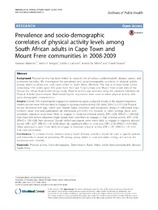| dc.description.abstract | BACKGROUND: Physical activity has been linked to reduced risk of various cardiometabolic disease, cancer, and
premature mortality. We investigated the prevalence and socio-demographic correlates of physical activity
among adults in urban and rural communities in South Africa. METHODS: This was a cross-sectional survey
comprising 1733 adults aged ?35 years from the Cape Town (urban) and Mount Frere (rural) sites of the
Prospective Urban Rural Epidemiology study. Physical activity was assessed using the validated International
Physical Activity Questionnaire. Multinomial logistic regressions were used to relate physical activity with
socio-demographic characteristics.
RESULTS: Overall, 74% of participants engaged in moderate-to-vigorous physical activity. In the adjusted regression
models, women were 34% less likely to engage in vigorous physical activity (OR =0.66, 95%-CI = 0.47-0.93). Physical
activity decreased with age, varied with marital status, education and occupation, always in differential ways
between urban and rural participants (all interactions p ? 0.047). For instance, in urban settings, those with
secondary education were more likely to engage in moderate physical activity (OR = 2.06, 95%-CI = 1.08-3.92)
than those with tertiary education. Single people were more likely to engage in high physical activity (OR = 2.10,
95%-CI = 1.03-4.28) than divorced. Overall, skilled participants were more likely to engage in vigorous physical
activity (OR = 2.07, 95%-CI = 1.41-3.05) driven by significant effect in rural area (OR = 2.70, 95%-CI = 1.51-4.83).
Urban participants were more likely to engage in moderate physical activity (OR = 1.67, 95%-CI = 1.31-2.13)
than rural participants.
CONCLUSIONS: To prevent chronic diseases among South Africans, attention should be paid to specific policies
and interventions aimed at promoting PA among young adults in rural and urban setting, and across the
social-economic diversity. | en_US |

